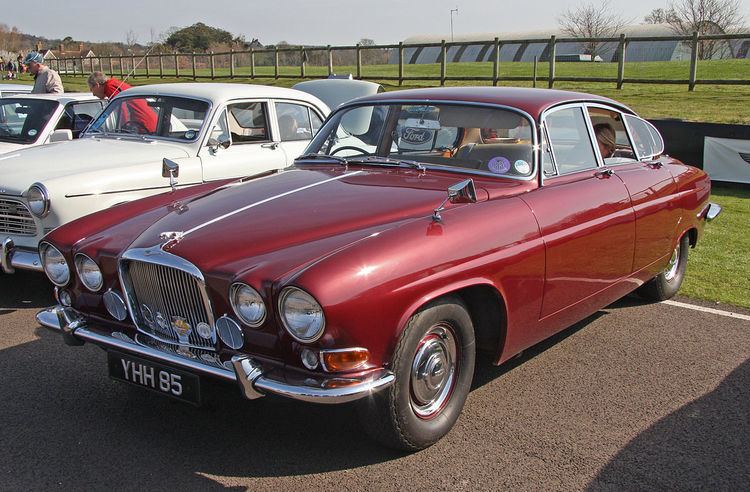Body style 4-door saloon | Layout FR layout | |
 | ||
Production 1961–19703.8 Litre: 13,3824.2 Litre: 5,137420G: 5,763 Class Full-size luxury car (F) | ||
The Jaguar Mark X (Mark ten) was the top-of-the-range saloon car built by the British manufacturer Jaguar, primarily aimed at the United States market. The Mark X succeeded the Mark IX as the company's largest saloon model.
Contents
Body
The unitary construction body-shell was codenamed "Zenith" during development and this floor pan continued in production long after Mark X production ended, as the DS 420 Limousine. The new style, four headlamps set into rounded front fenders with a vaned grill, first appeared on the Mark X. The interior was the last Jaguar with abundant standard woodwork, including the dashboard, escutcheons, window trim, a pair of large bookmatched fold out rear picnic tables, and a front seat pull-out picnic table stowed beneath the instrument cluster. Later, air conditioning and a sound-proof glass division between the front and rear seats were added as options.
From its introduction in mid-October 1961 until the arrival in 1992 of the low-slung XJ220, the Mark X stood as one of the widest production Jaguars ever built. Asked in 1972 if he thought the Mark X had grown rather too large, Jaguar chairman William Lyons, agreed that it "definitely" had: he opined that the then recently introduced and notably more compact Jaguar XJ6 was, by contrast an "ideal size".
The substantial doors required helical torsion springs inside the door pillars to enable them to be opened from the inside with an acceptably low level of effort.
Mechanical
The Mark X was the first Jaguar saloon to feature independent rear suspension. It differed from earlier large Jaguar saloons in having 14" wheels instead of the more common 15". It used a wider-track version of Jaguar's IRS unit first seen on the E Type, which was subsequently used on Jaguar vehicles until XJ-S production ended in 1996. The front suspension used double wishbones with coil springs and telescopic dampers. The car initially featured a 3781 cc version of Jaguar's XK in-line six-cylinder engine. A 9:1 compression ratio was standard, but an alternative 8:1 compression ratio was available as an option. For the London Motor Show in October 1964 the enlarged 4,235 cc unit took over, although the 3.8-litre unit could still be specified until October 1965. Triple SU carburettors were fitted, fed from an AC Delco air filter mounted ahead of the right hand front wheel.
Transmission options were manual, manual with overdrive, automatic, or automatic with overdrive. The arrival of the 4.2-litre power unit coincided with the introduction of a newly developed all-synchromesh four-speed gear box, replacing the venerable box inherited by the 3.8-litre Mark X from the Mark IX, which had featured synchromesh only on the top three ratios. Many domestic market cars and almost all cars destined for the important North American markets left the factory with a Borg Warner automatic gear-box. The 4.2-litre engine's introduction was also marked by a transmission upgrade for buyers of the automatic cars, who saw the Borg Warner transmission system switched from a DG to a Typ-8 unit. The power train was completed by a Thornton Powr-Lok limited-slip differential.
Stopping power for this heavy car came from power-assisted disc-brakes on all four wheels.
Power-assisted steering was standard, the later 4.2 cars receiving Marles Varamatic Bendix (Adwest) variable ratio steering boxes, designed by an Australian, Arthur Bishop.
420G
For the London Motor Show in October 1966 the Mark X was renamed the Jaguar 420G (not to be confused with the smaller Jaguar 420). The 420G was distinct from the Mark X only with the addition of a vertical central bar splitting the grille in two, side indicator repeaters on the front wings, and a chrome strip along the wing and door panels (two tone paint schemes were also available with the chrome strip omitted).
Interior changes included perforations in the central sections of the leather seats, padded dashboard sections for safety, moving the clock to a central position, and the introduction of air conditioning as an option.
A limousine body was available on the standard wheelbase. A glass-topped partition and front bench seat replaced the separate chairs of standard cars.
Despite running for the same length of time as the Mark X (five years) the 420G sold in less than a third of the numbers. This lack of popularity and the increasing production of the smaller XJ6 resulted in the 420G being run out of production in 1970.
Eight seater
In 1968 British Leyland ended production of the Daimler limousine DR450 and the Austin Princess and chose to replace them by offering a 141 in (3,600 mm) extra-long wheelbase 420G with an eight-seater Hooper-Empress-shaped but still monocoque body made by Vanden Plas. Aside from the shape of the rear part of the coachwork there was no link with Daimler cars made before Daimler became a subsidiary.
British Leyland's "Daimler DS420" was announced in June 1968. Taller than the 420G the new car was nearly nineteen feet long and six feet six inches wide with "majestic proportions". The rear compartment carried six people in comfort on the rear seats and three fold-away occasional seats. Sir William Lyons pointed out it was less than half the price of any of its competitors.
The 420G wheelbase was extended by 21", with the mechanical underpinnings of the car being subtly reconfigured. This eight-seater car was built until 1992 and used by many countries in official capacities. It was frequently used by funeral homes for carrying mourners or as a hearse.
